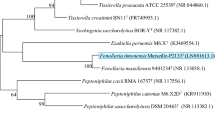Abstract
Fourteen strains isolated from figs, caprifigs, and fig wasps collected in California and Tunisia, and from a small black ant in France, constitute a new DNA hybridization group that is 25–56% related toSerratia species, and 6–17% related to other species of Enterobacteriaceae. This homogeneous group (90% relatedness within the group) constitutes a new species that is namedSerratia ficaria sp. nov. (type strain, ICPB 4050, ATCC 33105). Strains of this species have a characteristic odor, similar to that ofS: odorifera andPseudomonas perolens. No strain ofS. ficaria has yet been recovered from clinical specimens.
Similar content being viewed by others
Literature Cited
Brenner, D. J., Fanning, G. R., Johnson, K. E., Citarella, R. V., Falkow, S. 1969. Polynucleotide sequence relationships among members of theEnterobacteriaceae. Journal of Bacteriology98:637–650.
Brenner, D. J., Fanning, G. R., Skerman, F. J., Falkow, S. 1972. Polynucleotide sequence divergence among strains ofEscherichia coli and closely related organisms. Journal of Bacteriology109:953–965.
Caldis, P. D. 1927. Etiology and transmission of endosepsis (internal rot) of the fruit of the fig. Hilgardia2:287–328.
Condit, I. J. 1947. The Fig. Waltham: Chronica Botanica.
Crosa, J. H., Brenner, D. J., Falkow, S. 1973. Use of a singlestrand specific nuclease for analysis of bacterial and plasmid deoxyribonucleic acid homo- and heteroduplexes. Journal of Bacteriology115:904–911.
Crosa, J. H., Steigerwalt, A. G., Fanning, G. R., Brenner, D. J. 1974. Polynucleotide sequence divergence in the genusCitrobacter. Journal of General Microbiology83:271–282.
Edwards, P. R., Ewing, W. H. 1972. Identification ofEnterobacteriaceae, 3rd ed. Minneapolis, Burgess Publishing Co.
Ericsson, H. M., Sherris, J. C. 1971. Antibiotic sensitivity testing: Report of an international collaborative study. Acta Pathologica et Microbiologica Scandinavica, Suppl.217:64–71.
Grimont, P. A. D., Dulong de Rosnay, H. L. C. 1972. Numerical study of 60 strains ofSerratia. Journal of General Microbiology72:259–268.
Grimont, P. A. D., Grimont, F. 1979. The genusSerratia. In: Starr, M. P., Stolp, H., Trüper, H. G., Balows, A., Schlegel, H. G. (eds.). The prokaryotes. A handbook on habitats, isolation, and identification of bacteria. New York: Springer-Verlag, In press.
Grimont, P. A. D., Grimont, F., Dulong de Rosnay, H. L. C., Sneath, P. H. A. 1977. Taxonomy of the genusSerratia. Journal of General Microbiology98:39–66.
Grimont, P. A. D., Grimont, F., Richard, C., Davis, B. R., Steigerwalt, A. G., Brenner, D. J. 1978. Deoxyribonucleic acid relatedness betweenSerratia plymuthica and otherSerratia species, with a description ofSerratia odorifera sp. nov. (type strain: ICPB 3995). International Journal of Systematic Bacteriology28:453–463.
Grimont, P. A. D., Grimont, F., Starr, M. P. 1978.Serratia proteamaculans (Paine and Stansfield) comb. nov., a senior subjective synonym ofSerratia liquefaciens (Grimes and Hennerty) Bascomb et al. International Journal of Systematic Bacteriology28:503–510.
McConaughy, B. L., McCarthy, B. J. 1970. Related base sequences in the DNA of simple and complex organisms. VI. The extent of base sequence divergence among the DNAs of various rodents. Biochemical Genetics4:425–446.
Miller, M. W., Phaff, H. J. 1962. Successive microbial populations in Calimyrna figs. Applied Microbiology10:394–400.
Miller, A., III, Scanlan, R. A., Lee, J. S., Libbey, L. M., Morgan, M. E. 1973. Volatile compounds produced in sterile fish muscle (Sebastes melanops) byPseudomonas perolens. Applied Microbiology25:257–261.
Owen, R. J., Hill, L. R., Lapage, S. P. 1969. Determination of DNA base compositions from melting profiles in dilute buffers. Biopolymers7:503–516.
Phaff, H. J., Miller, M. W. 1961. A specific microflora associated with the fig wasp:Blastophaga psenes linnaeus. Journal of Insect Pathology3:233–243.
Richard, C., Joly, B., Sirot, J., Stoleru, G. H., Popoff, M. 1976. Etude de souches deEnterobacter appartenant à un groupe particulier proche deE. aerogenes. Annales de Microbiologie (Paris)127A:545–548.
Starr, M. P., Grimont, P. A. D., Grimont, F., Starr, P. B. 1976. Caprylate-thallous agar medium for selectively isolatingSerratia and its utility in the clinical laboratory. Journal of Clinical Microbiology4:270–276.
Steigerwalt, A. G., Fanning, G. R., Fife-Asbury, M. A., Brenner, D. J. 1976. DNA relatedness among species ofEnterobacter andSerratia. Canadian Journal of Microbiology22:121–137.
Sutton, W. D. 1971. A crude nuclease preparation suitable for use in DNA reassociation experiments. Biochimica et Biophysica Acta240:522–531.
Véron, M. 1975. Nutrition et taxonomie desEnterobacteriaceae et bactéries voisines. I. Méthode d’étude des auxanogrammes. Annales de Microbiologie (Paris)126A:267–274.
Author information
Authors and Affiliations
Rights and permissions
About this article
Cite this article
Grimont, P.A.D., Grimont, F. & Starr, M.P. Serratia ficaria sp. nov., a bacterial species associated with Smyrna figs and the fig waspBlastophaga psenes. Current Microbiology 2, 277–282 (1979). https://doi.org/10.1007/BF02602859
Issue Date:
DOI: https://doi.org/10.1007/BF02602859




